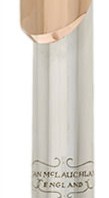Probably the most important stage of making a headjoint is cutting the embouchure hole. It is this that really makes it work or not.
 When I cut the embouchure hole, I use a tool called a scraper. It’s a wooden handle with a blade shaped like a triangular file, about 15mm long. However, instead of having file teeth on each surface, the faces are ground to a mirror finish, giving three very sharp cutting edges.
When I cut the embouchure hole, I use a tool called a scraper. It’s a wooden handle with a blade shaped like a triangular file, about 15mm long. However, instead of having file teeth on each surface, the faces are ground to a mirror finish, giving three very sharp cutting edges.
I start by using a series of gauges which show the angles required at the front, back and sides of the hole, and also the outside curvature of the lip plate. I cut the hole so that it is a minimum size from front to back, from side to side, and so that the diagonals are the correct length.
From this stage, I finish cutting the hole by playing the headjoint on my own flute, until I feel satisfied with the result. This may take 5 minutes, or sometimes I have to put the headjoint aside and start work on it again the next day! Either way the headjoint must blow well and be characteristically ‘one of mine’.
When making a flute headjoint, the following points are the most important to me:
- Good dynamics throughout the whole range.
- Good articulation throughout the full range when played loud and soft.
- A wide range of tone colours available.
- An even sound throughout the full range.
- Plays in tune.
When the headjoint has all the above features it is ready to polish and finish.
I polish inside the riser using emery paper. This is done very carefully by hand, being sure not to alter any angles, as this could drastically alter the headjoint. I polish the outside on a buffing wheel, which has a fine polishing powder on its surface and gives an excellent finish.
I then play the headjoint again on my flute, and if I am still happy with it, my name is engraved on the tube!
Every maker aims for different things and produces very different results and, due to the fact that headjoints are so personal to the player, it seems to me that nobody can ever produce ‘the’ perfect headjoint. We all strive for perfection, but there always seems to be room for experimentation and improvement. Long may this continue!
This article was originally written by Ian McLauchlan for Flutewise.

